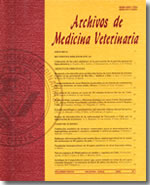Cervical intravertebral disk herniation (Schmorl's node) in a dog
Main Article Content
Abstract
A two year old male mixed dog was refered for evaluation of acute paralysis. On the initial examination, the dog had tetraplegia and vesical and anal atony. No spinal reflex and superficial or deep sensation were detected behind the craneal neck. Result of CBC and serum biochemical analysis were within references ranges. Two days after the onset of sign, due to severe respiratory distress the dog died of respiratory paralysis. The anatomopathologic study revealed a cervical medular compression due to pathologic herniation of the nucleus pulposus into the trabecular bone of the caudal endplate of the body vertebra of C3. The herniation of the disk material into the vertebral body are known as Schmorl`s node. The ocurrence of these disease in dogs is uncommon. This report also discussed the mechanism of Schmorl`s node in dogs as well as in human beings.

